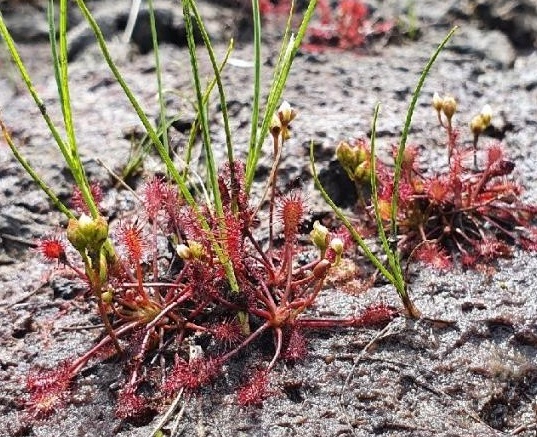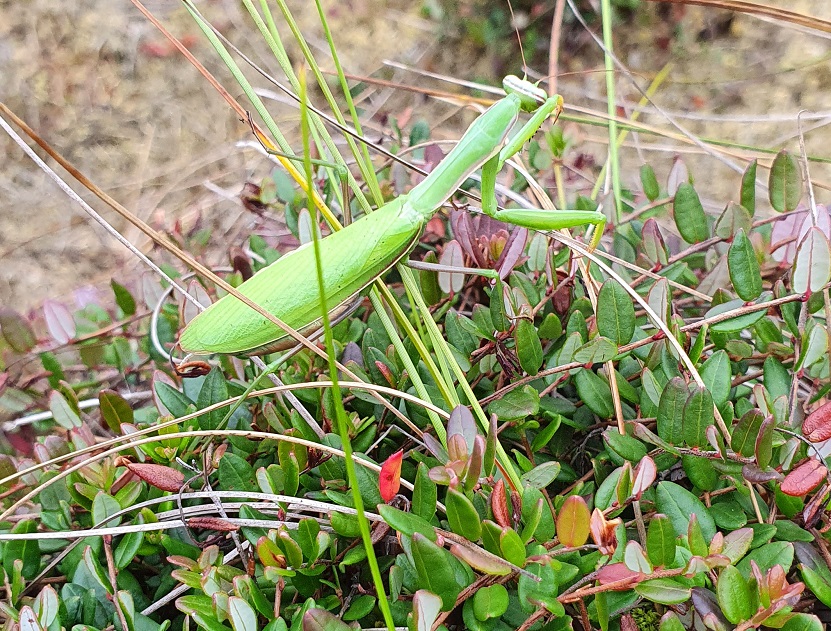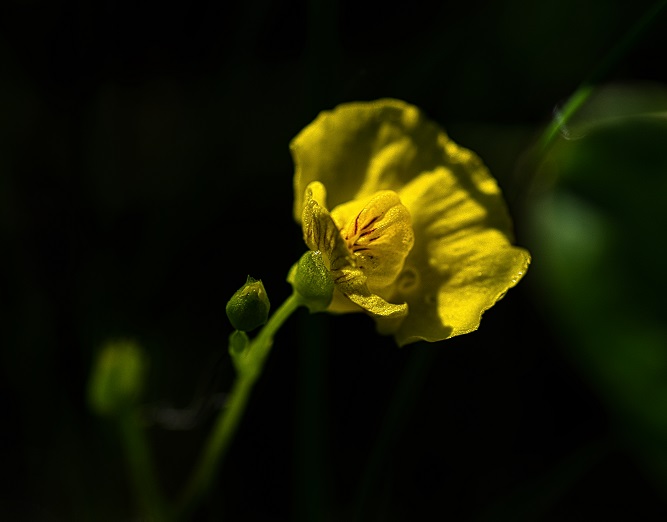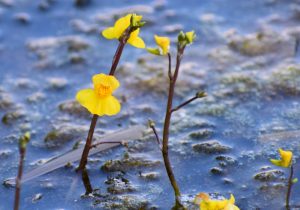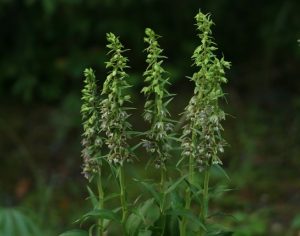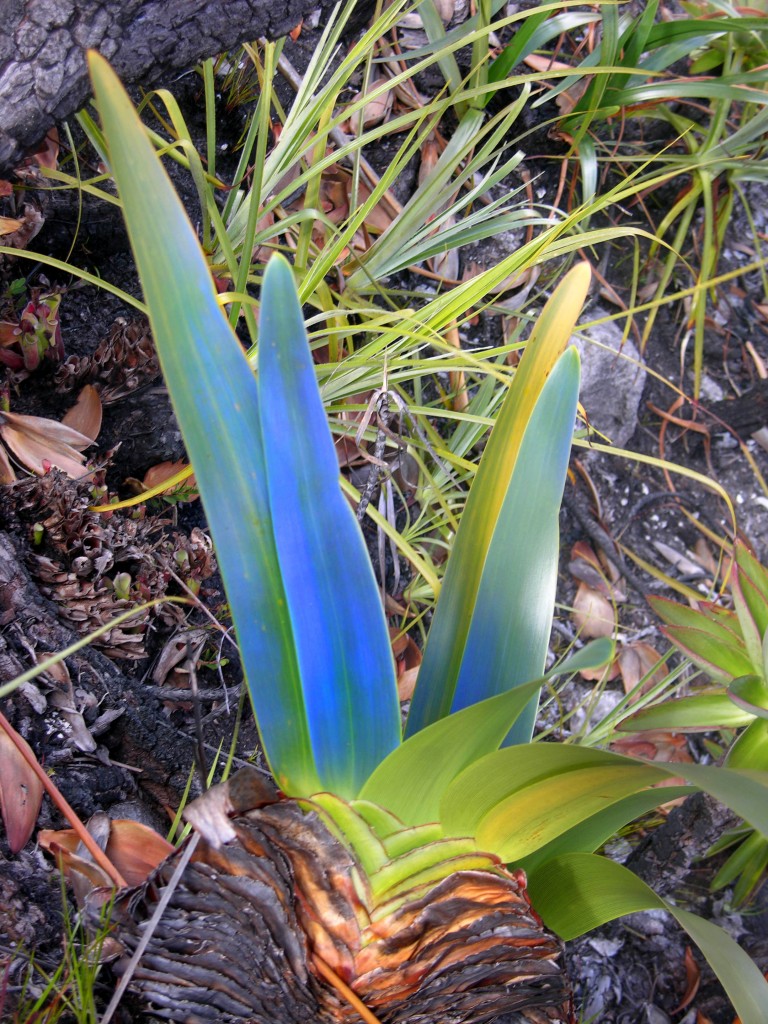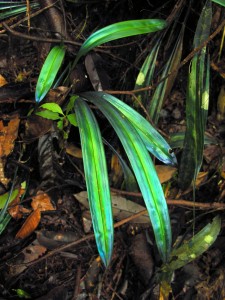 Across tropical regions of Asia, Africa and the Americas, an increasing number of plant species have been identified to produce leaves that exhibit a conspicuous and often brilliant iridescence. The startling shine is generally attributed to reflective granules in the epidermal cells of the leaves. The granules reflect specific light wavelengths (especially bluish light), causing the leaves to shine with a specific colour or hue; generally blue, green or occasionally purple. In most iridescent plant species, the colouration of the foliage sports a single iridescent colour, although at least one species of Selaginella may produce foliage with a blue shine as well as small reddish pink iridescent patches.
Across tropical regions of Asia, Africa and the Americas, an increasing number of plant species have been identified to produce leaves that exhibit a conspicuous and often brilliant iridescence. The startling shine is generally attributed to reflective granules in the epidermal cells of the leaves. The granules reflect specific light wavelengths (especially bluish light), causing the leaves to shine with a specific colour or hue; generally blue, green or occasionally purple. In most iridescent plant species, the colouration of the foliage sports a single iridescent colour, although at least one species of Selaginella may produce foliage with a blue shine as well as small reddish pink iridescent patches.
Most (possibly all) large iridescent plant species are confined to tropical latitudes, and are generally associated with lowland, shady, vegetated environments. A few exceptional species grow in highland habitats in direct sunlight, but these cases are few. The best known of all iridescent plants belong to the genus Selaginella which is distributed widely across tropical Southeast Asia and Africa. Selaginella willdenovii is among the most common and most prominent iridescent species, and produces delicate fronds up to 30 cm long, bearing small leaflets a few milimetres in length. The upper surface of the foliage of S. willdenovii exhibits a brilliant electric blue shine that is visible only from certain angles. Different populations of S. willdenovii appear to vary profoundly in terms of the brilliance of the iridescent shine, and it seems that environmental factors (namely ambient light levels) play a major role in influencing the shine of the plants leaves. Selaginella willdenovii is predominantly a lowland species, growing on the floor of sparse forest and scrub, and generally the S. willdenovii plants with the most brilliant shine grow in light shade, whereas the iridescence is greatly reduced in those plants growing in full sunlight or very dark conditions.
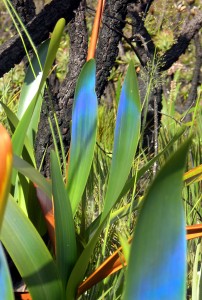 In South America, Stegolepis – an equally spectacular genus of iridescent plants – grows on the tepuis. the immense sandstone plateaus which are scattered across the borderlands of Venezuela and Brazil. The most spectacular species of iridescent Stegolepis is S. hitchcockii which is found only in a few valleys on the summit of one mountain – Mount Neblina. Stegolepis hitchcockii grows upright amidst scrub in full sunlight, and gradually forms a broad but narrow fleshy stem from the top of which, broad, 30 – 60 cm long, strap shaped leaves emanate and form an upright arc of foliage. One side of each individual leaf is yellowish emerald in colour while the other side is dark sea green. The dark green side has a glossy translucent cuticle which flashes intense, iridescent blue at certain angles. Where many iridescent blue Stegolepis hitchcockii plants grow together, the landscape sparkles and flickers electric blue as the leaves move gently in the wind.
In South America, Stegolepis – an equally spectacular genus of iridescent plants – grows on the tepuis. the immense sandstone plateaus which are scattered across the borderlands of Venezuela and Brazil. The most spectacular species of iridescent Stegolepis is S. hitchcockii which is found only in a few valleys on the summit of one mountain – Mount Neblina. Stegolepis hitchcockii grows upright amidst scrub in full sunlight, and gradually forms a broad but narrow fleshy stem from the top of which, broad, 30 – 60 cm long, strap shaped leaves emanate and form an upright arc of foliage. One side of each individual leaf is yellowish emerald in colour while the other side is dark sea green. The dark green side has a glossy translucent cuticle which flashes intense, iridescent blue at certain angles. Where many iridescent blue Stegolepis hitchcockii plants grow together, the landscape sparkles and flickers electric blue as the leaves move gently in the wind.
Of the approximately twenty species of Stegolepis that are recognized, several others have faint iridescent shines to their leaves. The much smaller species Stegolepis ligulata produces proportionately narrower and shorter leaves which shimmer with a purple brilliance that is most intense when the leaves are wet or submerged. The leaves of this species curl as they dry and eventually lose their shine altogether. Both S. hitchcockii and S. lingulata are highland species growing above 1,500 m altitude. They appear to produce most brilliant iridescent shines when growing in direct sunlight.
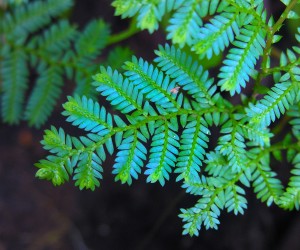 Growing among the Stegolepis there is at least one species of iridescent fern, named Elaphoglossum wurdackii. This plant has evolved a similar iridescent leaf epidermis, and much like S. willdenovii, it favours shaded, sheltered habitat often beneath or between great boulders. The leaves of E. wurdackii are strap shaped or oval and usually dark greyish green but like the iridescent Stegolepis, flash intense turquoise at certain angles.
Growing among the Stegolepis there is at least one species of iridescent fern, named Elaphoglossum wurdackii. This plant has evolved a similar iridescent leaf epidermis, and much like S. willdenovii, it favours shaded, sheltered habitat often beneath or between great boulders. The leaves of E. wurdackii are strap shaped or oval and usually dark greyish green but like the iridescent Stegolepis, flash intense turquoise at certain angles.
During an expedition to Borneo in 2006, I encountered a spectacular iridescent plant species in central Sarawak, growing in dappled shade in dense, lowland rainforest. The plant produces metallic-iridescent leaves with a blue or greenish shine, sometimes with a pinkish blush towards the apex. Although greatly resembling species of ferns, the plants which I encountered bore small, white flowers, however all attempts by botanists to identify this mysterious iridescent species have been unsuccessful.
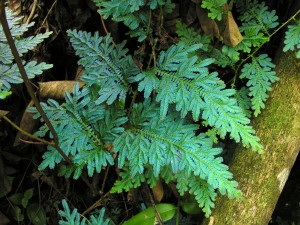 We still have much to learn of the mysterious iridescent plants of the world. Indeed, even the reason behind the iridescence remains unclear. It is not merely a mechanism to attract pollinators, since the iridescent ferns by their very nature do not flower and the iridescent Stegolepis species bloom sporadically yet produce glimmering leaves throughout the year. One plausible explanation may be that the iridescent shine serves to protect the leaves by reflecting the high component of ultra violet (blue) light, which is intense at higher elevations. Concentrated ultra violet light is known to have a damaging effect on the chloroplasts of most plant species and so perhaps by refracting the blue component of sunlight, the iridescent tepui plants have evolved a natural means of protection. However, this explanation is not convincing for the species which grow in lowland forests in relative shade and are naturally protected from high ultra violet light levels. Indeed, the tendency for Selaginella to lose its iridescence in direct sunlight contradicts these ideas.
We still have much to learn of the mysterious iridescent plants of the world. Indeed, even the reason behind the iridescence remains unclear. It is not merely a mechanism to attract pollinators, since the iridescent ferns by their very nature do not flower and the iridescent Stegolepis species bloom sporadically yet produce glimmering leaves throughout the year. One plausible explanation may be that the iridescent shine serves to protect the leaves by reflecting the high component of ultra violet (blue) light, which is intense at higher elevations. Concentrated ultra violet light is known to have a damaging effect on the chloroplasts of most plant species and so perhaps by refracting the blue component of sunlight, the iridescent tepui plants have evolved a natural means of protection. However, this explanation is not convincing for the species which grow in lowland forests in relative shade and are naturally protected from high ultra violet light levels. Indeed, the tendency for Selaginella to lose its iridescence in direct sunlight contradicts these ideas.
The factors that control the shine of the iridescent plants also remain poorly understood and little studied. In most cases, when brought into cultivation, the brilliance of the iridescence is lost or greatly reduced, even if cultivated plants are grown in conditions that accurately reflect the natural environment of the wild. Only a few iridescent plants (mainly Selaginella and the Asian fern Microsorum thailandicum) are grown easily and retain their beautiful iridescent colouration in cultivation, and these are increasingly being offered for sale by commercial plant retailers. Yet that so most other iridescent plant species remain so little known is surprising considering their often beautiful appearance and significant horticultural potential. Clearly we are only beginning to understand these beautiful but enigmatic members of the plant kingdom, and the reasons behind their glimmering, shiny foliage.
Stewart McPherson
